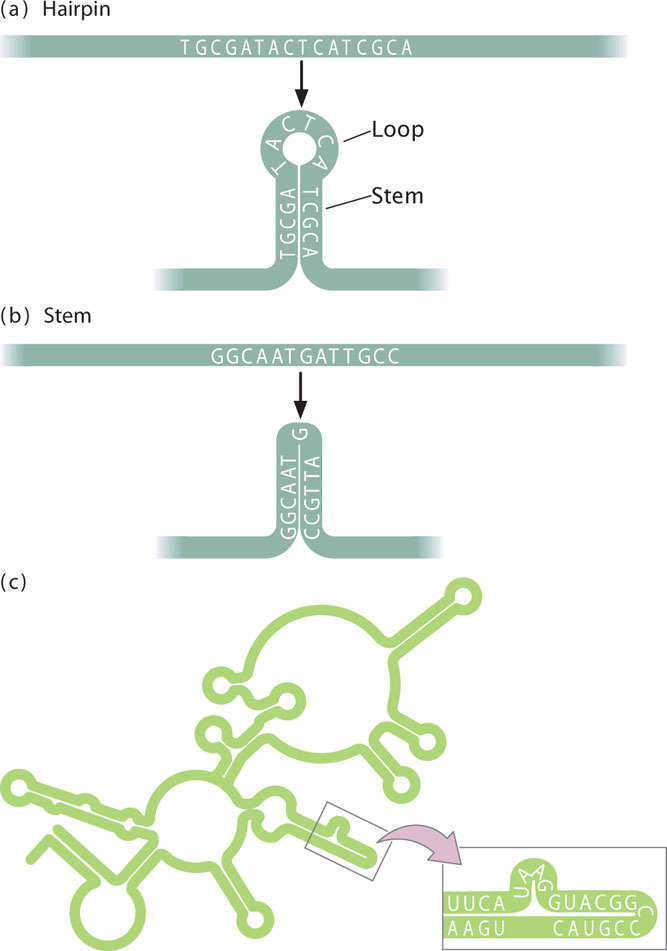10.4 Special Structures Can Form in DNA and RNA
Sequences within a single strand of nucleotides may be complementary to each other and can pair by forming hydrogen bonds, producing double-stranded regions (Figure 10.17). This internal base pairing imparts a secondary structure to a single-stranded molecule. One common type of secondary structure found in single strands of nucleotides is a hairpin, which forms when sequences of nucleotides on the same strand are inverted complements (see Figure 10.17a). A hairpin consists of a region of paired bases (the stem) and sometimes includes intervening unpaired bases (the loop). When the complementary sequences are contiguous, the hairpin has a stem but no loop (see Figure 10.17b). RNA molecules may contain numerous hairpins, allowing them to fold up into complex structures (see Figure 10.17c). Secondary structures play important roles in the functions of many RNA molecules, as we will see in Chapters 14 and 15.

DNA sequences can also sometimes form three-stranded (triplex) structures, called H-DNA, when some of the DNA unwinds and a single polynucleotide strand from one part of the molecule pairs with double-stranded DNA from another part of the molecule (Figure 10.18). This is possible because under certain conditions one base can simultaneously pair with two other bases. H-DNA often occurs in long sequences containing only purine bases or only pyrimidine bases. Some triplex structures consist of one strand of purines paired with two strands of pyrimidines; other triplex structures consist of one strand of pyrimidine paired with two strands of purines. Sequences capable of adopting an H-DNA confirmation are common in mammalian genomes and evidence suggests that H-DNA occurs under natural conditions. Recent research has demonstrated that H-DNA breaks more readily than double-stranded DNA, which then leads to higher rates of mutation where H-DNA structures occur. Quadruplex structures involving four strands of DNA can also occur under certain conditions.  TRY PROBLEM 39
TRY PROBLEM 39

CONCEPTS
In DNA and RNA, base pairing between nucleotides on the same strand produces special secondary structures such as hairpins. Triple-stranded DNA structures can arise when a single strand of DNA pairs with double-stranded DNA.
 CONCEPT CHECK 9
CONCEPT CHECK 9Hairpins are formed in DNA as a result of
- sequences on the same strand that are inverted and complementary.
- sequences on the opposite strand that are complements.
- sequences on the same strand that are identical.
- sequences on the opposite strand that are identical.
The primary structure of DNA can be modified in various ways. One such modification is DNA methylation, a process in which methyl groups (–CH3) are added (by specific enzymes) to certain positions on the nucleotide bases. Bacterial DNA is frequently methylated to distinguish it from foreign, unmethylated DNA that may be introduced by viruses; bacteria use proteins called restriction enzymes to cut up any unmethylated viral DNA (see Chapter 19). In eukaryotic cells, methylation is often related to gene expression. Sequences that are methylated typically show low levels of transcription while sequences lacking methylation are actively being transcribed (see Chapter 17). Methylation can also affect the three-dimensional structure of the DNA molecule.
Adenine and cytosine are commonly methylated in bacteria. In eukaryotic DNA, cytosine bases are sometimes methylated to form 5-methylcytosine (Figure 10.19). The extent of cytosine methylation varies among eukaryotic organisms; in most animal cells, about 5% of the cytosine bases are methylated, but there is no methylation of cytosine in yeast and more than 50% of the cytosine bases in some plants are methylated. Why eukaryotic organisms differ so widely in their degree of methylation is not clear.

CONCEPTS
Methyl groups may be added to certain bases in DNA, depending on the positions of the bases in the molecule. Both prokaryotic and eukaryotic DNA can be methylated. In eukaryotes, cytosine bases are most often methylated to form 5-methylcytosine and methylation is often related to gene expression.